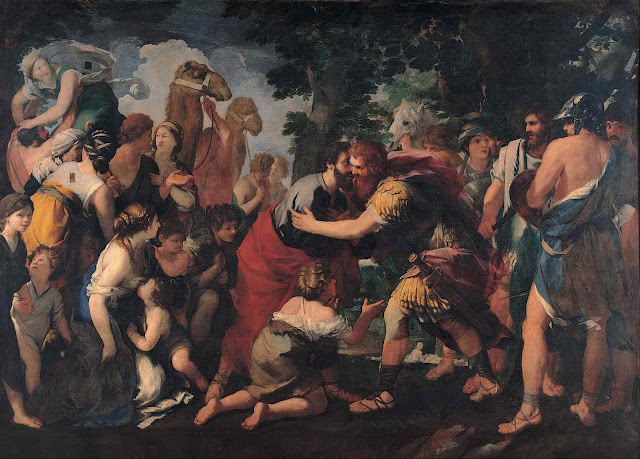 |
| Maria Felice Subleyras, née Tibaldi Dinner at the House of the Pharisee ca. 1748 watercolor on vellum Pinacoteca Capitolina, Rome |
"Mary Magdalene at the feet of Jesus Christ in the house of Simon the Pharisee. It is a copy of the picture by the artist's husband, Pierre Subleyras, a picture now in the Louvre. Maria Tibaldi Subleyras presented this copy to Pope Benedict XIV, who sent her a thousand scudi and placed her work in his collection at the Capitol."
– Picture Gallery of the Capitoline Museums (Musei Capitolini) on Piazza del Campidoglio in Rome
 |
| attributed to Andrea Lucatelli Finding of Romulus and Remus ca. 1720-40 oil on canvas Pinacoteca Capitolina, Rome |
 |
| Giovanni Bonati Madonna and Child with Saints ca. 1666-77 oil on canvas Pinacoteca Capitolina, Rome |
 |
| Giovanni Bonati Madonna and Child 1660s oil on canvas Pinacoteca Capitolina, Rome |
"But how did the installation of paintings in Roman galleries relate to the viewing practices of their guests? When paintings of the same genre or school were hung together in Roman collections, viewers naturally compared them. Selected paintings or small groupings within large installations may also have been set up for comparison, as, for instance, at the Capitoline picture gallery in the Palazzo dei Conservatori on the Campidoglio. The contents of the two-room Capitoline gallery were first published in Ridolfino Venuti's 1766 guidebook to Rome, which listed the pictures on every wall but did not indicate their specific arrangement. Although we do not know how Venuti's lists corresponded to the pictures' placement, they include some works listed in consecutive order that would have formed ideal pairings or groupings for comparison. On the first wall of the first gallery, for example, were two images of Saint Mary Magdalene, one by Francesco Albani (ca. 1640) and the other by Domenico Tintoretto (ca. 1598), which allowed visitors to asses the relative merits of the artists' styles – individual, period, and regional (Bolognese and Venetian, respectively) – in their treatment of the same subject. Also on that wall were two images of the Holy Family by the Emilian painter Benvenuto Garofalo, affording the possibility to compare paintings of the same theme by the same artist. Similarly on the last wall in the second gallery there were six small vedute (views; 1682-88) of Rome, painted in tempera by Gaspar van Wittel, a Dutch landscape painter known in Italy as Gaspare Vanvitelli."
– from Carole Paul's chapter, The Grand Tour and the Economy of Display, in Display of Art in the Roman Palace, 1550-1750 edited by Gail Feigenbaum (Getty Research Institute, 2014)
 |
| François Perrier Moses Striking the Rock 1642 oil on canvas Pinacoteca Capitolina, Rome |
 |
| Giovanni Maria Bottalla Meeting between Esau and Jacob ca. 1636-41 oil on canvas Pinacoteca Capitolina, Rome |
 |
| Giovanni Francesco Romanelli David with the Head of Goliath ca. 1635-40 oil on canvas Pinacoteca Capitolina, Rome |
 |
| Giovanni Francesco Romanelli Abduction of Helen ca. 1630-32 oil on canvas Pinacoteca Capitolina, Rome |
 |
| Paolo Veronese Allegorical Figure of Peace 1551-52 oil on canvas Pinacoteca Capitolina, Rome |
 |
| Paolo Veronese Allegorical Figure of Good Government 1551-52 oil on canvas Pinacoteca Capitolina, Rome |
 |
| Benvenuto Garofalo Adoration of the Sheperds 1536-37 oil on panel Pinacoteca Capitolina, Rome |
 |
| Benvenuto Garofalo St Lucy ca. 1535-40 oil on panel Pinacoteca Capitolina, Rome |
 |
| Benvenuto Garofalo Annunciation 1528 oil on panel Pinacoteca Capitolina, Rome |
 |
| Benvenuto Garofalo Madonna and Child in Glory 1530 oil on panel Pinacoteca Capitolina, Rome |
from LIFE OF BENVENUTO GAROFALO
"Then, in the year 1505, being sent for by Messer Geronimo Sagrato, a gentleman of Ferrara, who was living in Rome, Benvenuto returned there with the greatest willingness, and particularly from a desire to see the miracles that were being related of Raffaello da Urbino and of the Chapel of Julius painted by Buonarroti. But when Benvenuto had arrived in Rome, he was struck with amazement, and almost with despair, by seeing the grace and vivacity that the pictures of Raffaello revealed, and the depth in the design of Michelangelo. Wherefore he cursed the manners of Lombardy, and that which he had learned with so much study and effort at Mantua, and right willingly, if he had been able, would he have purged himself of all that knowledge; but he resolved, since there was no help for it, that he would unlearn it all, and, after the loss of so many years, change from a master into a disciple. And so he began to draw from such works as were the best and the most difficult, and to study with all possible diligence those greatly celebrated manners, and gave his attention to scarcely any other thing for a period of two whole years; by reason of which he so changed his method, transforming his bad manner into a good one, that notice was taken of him by the craftsmen. And, what was more, he so went to work with humility, and every kind of loving service, that he became the friend of Raffaello da Urbino, who, being very courteous and not ungrateful, taught Benvenuto many things, and always assisted and favored him."
– from the Life of Benvenuto Garofalo in Giorgio Vasari's Lives of the Painters, Sculptors and Architects (1568), translated by Gaston du C. de Vere (1912)